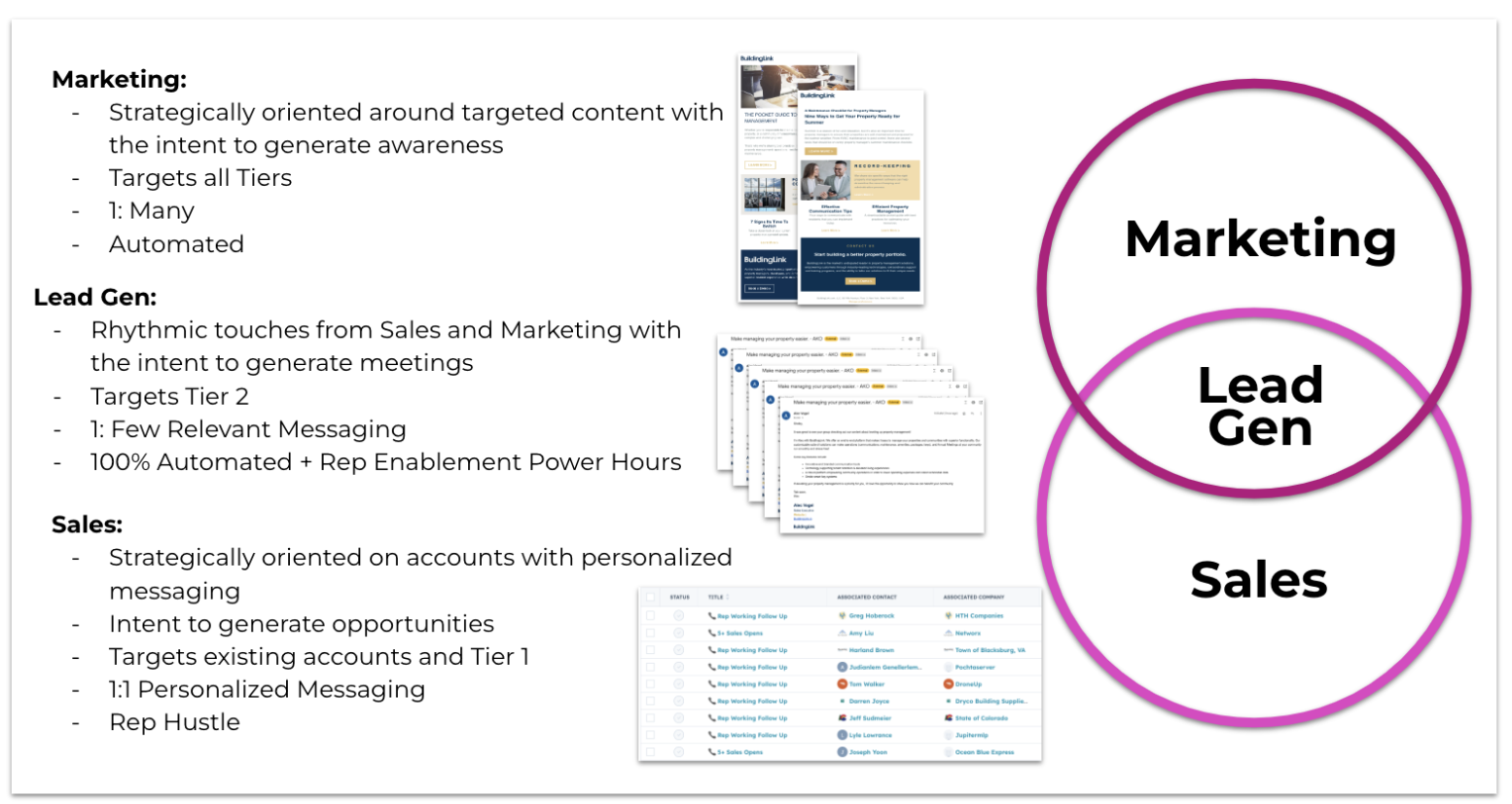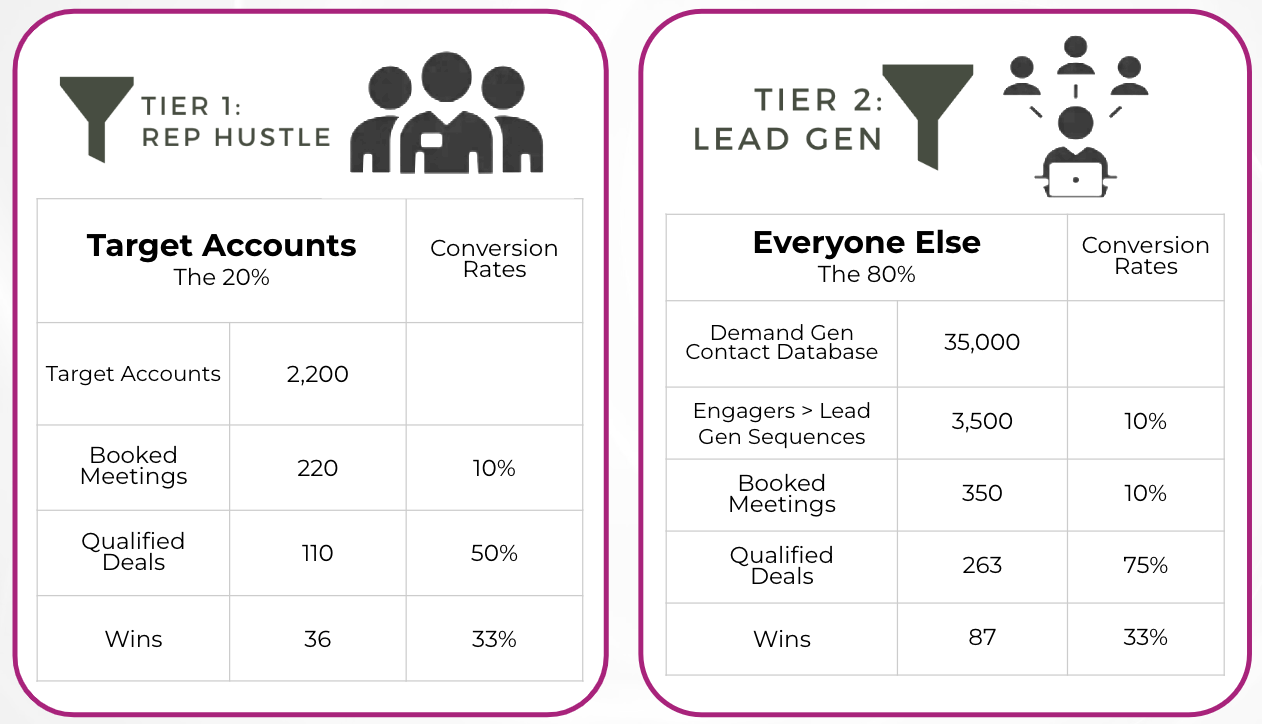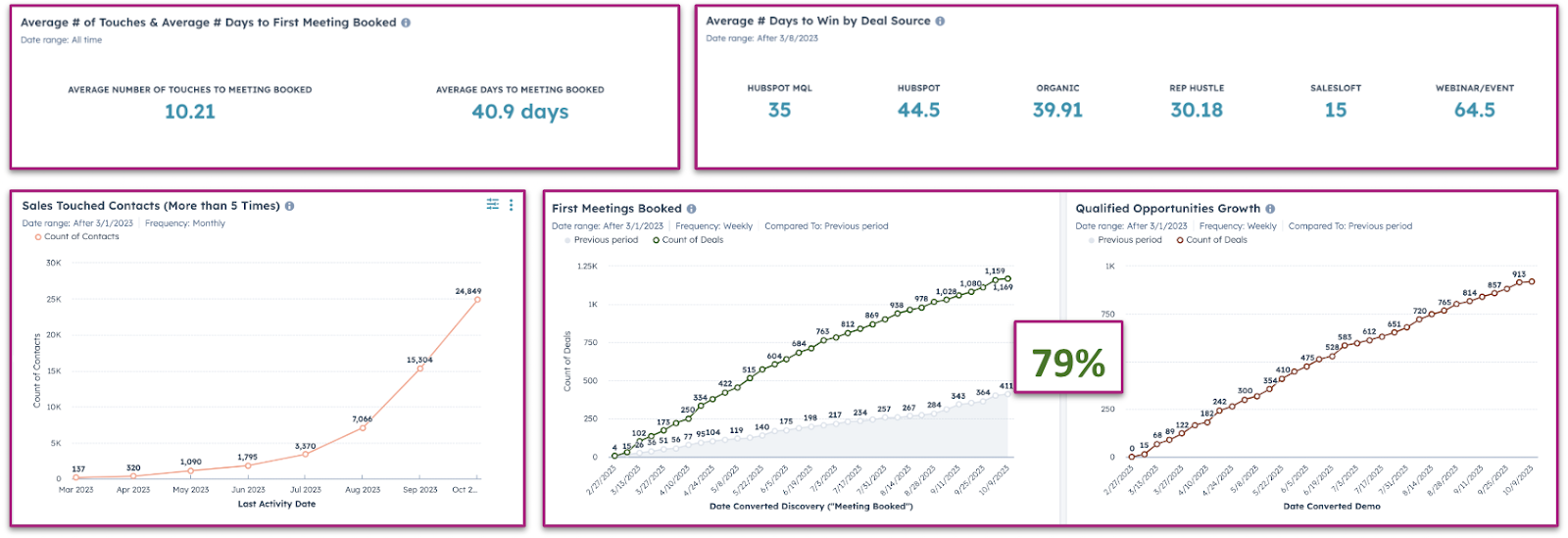The rise of go-to-market automation is colliding with the vast applications of generative AI. Lucky for those of us who are in sales, this is the superpower we’ve been waiting for. We can now research faster than ever with brief AI prompts, create meaningful content in seconds, and deploy proper sales automation of best-in-class sales orgs.
I recently presented to a room full of CROs and Sales Leaders in Vegas about expectations of a sales efficiency model. Some of these are new products going to market but most were established sales organizations needing to reimagine their approach. We talked tactically. We talked numbers. We talked about finding the “DNA of the sales pipeline”. This blog combines that presentation, the discussions that followed, and ultimately a case study of one of my favorite teams’ decisions to modernize how they go to market.
Why GTM Plays
The rhythmic touches from sales and marketing campaigns with the intent to generate pipeline do three incredible things for sales organizations:
- Creates top funnel consistency
- Builds an internally operating revenue engine that supports the sales goals
- Provides clarity and confidence in your campaign strategy.
Ultimately, this generates robust pipelines with better conversion rates. After all, we hire sales reps to have conversations and build relationships – not datamine for prospects or admin the CRM.
We can not sleep on this.
- Orgs with “GTM Play Experts” are 3x more likely to be best-in-class (top 10%).
- 84% of sales reps achieve quotas when their employer incorporates a best-in-class sales enablement strategy.
- 50% of sales time is wasted on unproductive prospecting.
- Sales reps spend an average of 440 hours each year trying to find the right sales content to share with their prospects.
The bottom line is that the best reps are looking for companies with stellar sales enablement programs. Most will prioritize this over their salary base when selecting their opportunities. Here’s how to be this kind of sales organization:
Do you have a solid handle on the essentials of GTM Plays?
- Is our data clean and structured? Are our emails validated and do the CRM fields allow for seamless segmentation to support our strategies? However you slice your pipeline reviews is the exact same way you should slice your marketing database.
- Do we adopt and support a continuous improvement mindset as the program evolves?
- Are we scheduling weekly reviews on conversion rates and accountable to the roadmap to actually strategically manage the program?
- Goals must stay oriented on the pipeline & sales conversions – not soft metrics like open rates, page views or form fills.
- Are we the executors who will do this right and do this fast?
3 GTM Components

Marketing:
The marketing touches are strategically oriented around targeted content with the intent to generate awareness. These campaigns can and should target the entire addressable market, as well as all persons of your customer base (users, influences, decision-makers, signers). These strategies are typically 1:Many messaging in a GTM Program and always automated. Think ads, newsletters, webinars, social media, etc.
Sales:
The sales touches are strategically oriented on accounts with personalized messaging with the intent to generate opportunities. This is when the reps themselves isolate key accounts worthy of manual intervention. Most typically consider these target accounts or Tier 1 opportunities. This strategy is deserving of 1:1 personalized messaging and is indicative of the rep’s hustle, as little automation supports the deployment of these activities.
Lead Gen:
This is where sales and marketing strategies blend in support of the pipeline. These rhythmic touches from both sales and marketing campaigns deploy with automation with the intent to generate meetings. This strategy leverages a 1:Few messaging structure based on relevance like tight firmographics, technographics, qualification logic, heavy segmentation, etc. This is highly automated but the best sales orgs will encourage their reps to lean into this strategy with strategies like High Engager Power Hours or Account-Based Call & Social Blitz.
Data + Marketing + Sales = GTM Plays
Check out this GIF first…
- The database is enhanced with a new account that includes two personas in our targeting.
- Meanwhile, there are daily signals of engagement of existing contacts in the database engaging with the current GTM programs.
- The marketing orchestration picks up on this new data and begins to nurture those contacts with consultative content, but contrary to the new contacts, those existing contacts with engagement signals will start to see stronger CTAs within their engagement on the site, in our emails, and on Linkedin.
- Immediately after the contacts meet MQL criteria, the sales orchestration determines if this prospect is best suited for…
- …the rep to hustle toward with his 1:1 prospecting or….
- if they should enroll from our lead gen automation instead. Either way, the contact will hit our AEs calendar once the meeting is booked.
- Simultaneously, a deal is created in Stage 1 because we already know the account and person are qualified. Plus, we want all the prior activity to roll up to the Opportunity so we know what exact touches it took to generate this at-bat. No crazy reporting combination of campaign and contact and opportunity objects – just a clean and simple deal report that illustrates the GTM plays and criteria that landed this opportunity.
We do this because we care for our reps and want to enable them — not encroach on them. Even better, this creates a rep-less experience for our prospects until they’re genuinely ready.
If that GIF didn’t sell you on it – how about the math?
An enterprise sales plan typically calls for roughly 80% of the revenue to come from about 20% of the known accounts in our database. This means we need our manpower behind the 20% of the database of our best and largest accounts… but we should not neglect the mid-market that makes up the other 80% of the database. After all, we may need to pull in more if we fall behind goal or we may identify some quick closes or high profitability accounts. So we need to facilitate a clean segmentation of our database to support both.
 Another great visual above – an annual model for 9 closers and a database of 50K contacts. Tier 2 meetings and deals are still assigned to those 9 closers, but that funnel is the responsibility of the demand gen/marketing team – not the rep.
Another great visual above – an annual model for 9 closers and a database of 50K contacts. Tier 2 meetings and deals are still assigned to those 9 closers, but that funnel is the responsibility of the demand gen/marketing team – not the rep.
Identifying the DNA of your pipeline (so much more than sales metrics)
When we have a well-oiled Rep Enablement Program utilizing GTM Plays, we know the following:
- Exactly how many sales and marketing touches it takes to book the first meeting (and how many days does that take)
- Exactly how many days it takes to win a deal by the channels that booked the meeting
- Exactly how many contacts have hit the “sweet spot” of the number of touches/messaging that we are currently pursuing
- Exactly how many meetings we can expect each month, and thanks to our conversion rate, how many qualified opportunities will hit the pipeline
- Exactly how many Enterprise vs Mid Market deals are warming up in the business development pipeline vs which Enterprise vs MidMarket are fully baked opportunities (progression x activity x segment)

The agility in GTM Plays can save your quarter. Literally.
We need to get our sales organizations to pragmatic execution – if we’re behind on a goal with only 40 days left in the quarter, what plays should we throw?
Real story – I was running point on sales enablement and we were $100K behind goal with only two Enterprise deals in Commit. Both were whales and unlikely to close in the quarter. So I ran two plays – one for existing pipeline and one for new.
- Play #1: Reviewed my # of Touches to Close report for Enterprise Accounts. After all, nothing is worse than a desperate sales rep so I needed to know what deals were in the appropriate lifecycle for this strategy. I learned that on average it takes 42 exchanges with the main POC for our reps to win a deal. Then I ran that same number across the active pipeline and found 4 deals were nearing that sweet spot (30-40 touches). The VP of Sales doubled down on only the 4 deals for the remainder of the quarter in hopes his executive involvement would encourage a smooth close in the quarter. They won a paid pilot for $9K and an Enterprise win for $80K.
- Play #2: I reviewed the cycle times of the mid-market deals and identified a specific title and industry that would be the quickest to not only book the meeting but also close within the 40 days. This includes 2 segments – new prospects and closed lost retry contacts that have not been contacted in 90+ days. I sent a combination of marketing and sales emails to this list of ~200 people and booked 3 meetings after the first email of the sales sequence. These extra 3 meetings produced one win of $22K within 30 days.
As a sales leader, could you imagine having someone aid you with plays like that? I love being every sales leader’s dream wingwoman.
Do it yourself (like now/soonish/tomorrow/ASAP)!
These recommendations often sound cumbersome and the truth is it requires a lot of collaboration and a continuous improvement mindset. But if you have a sales leader, a head of marketing, and a sales operations admin, you can get this off the ground in 3 weeks. Perhaps use the holiday slow-down time to realign and relaunch your efforts for the new year!
Use this chart below as an internal discussion guide for your sales and marketing team leads. How do you stack up? Which areas do you need to modernize? Do you have the people on staff to do this – quickly?
 I obsess over sales because we’re solving problems, connecting people and building a program that requires teamwork. This is what we do every day at AK Operations, and while we can do it very quickly and efficiently, most companies can master these simple principles if they’re given the priority and time it takes to define, decide and deploy.
I obsess over sales because we’re solving problems, connecting people and building a program that requires teamwork. This is what we do every day at AK Operations, and while we can do it very quickly and efficiently, most companies can master these simple principles if they’re given the priority and time it takes to define, decide and deploy.
Schedule an introduction to learn more!
